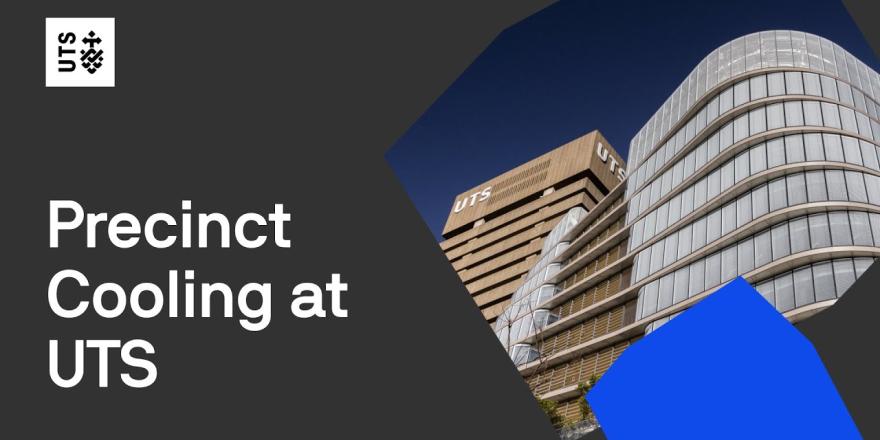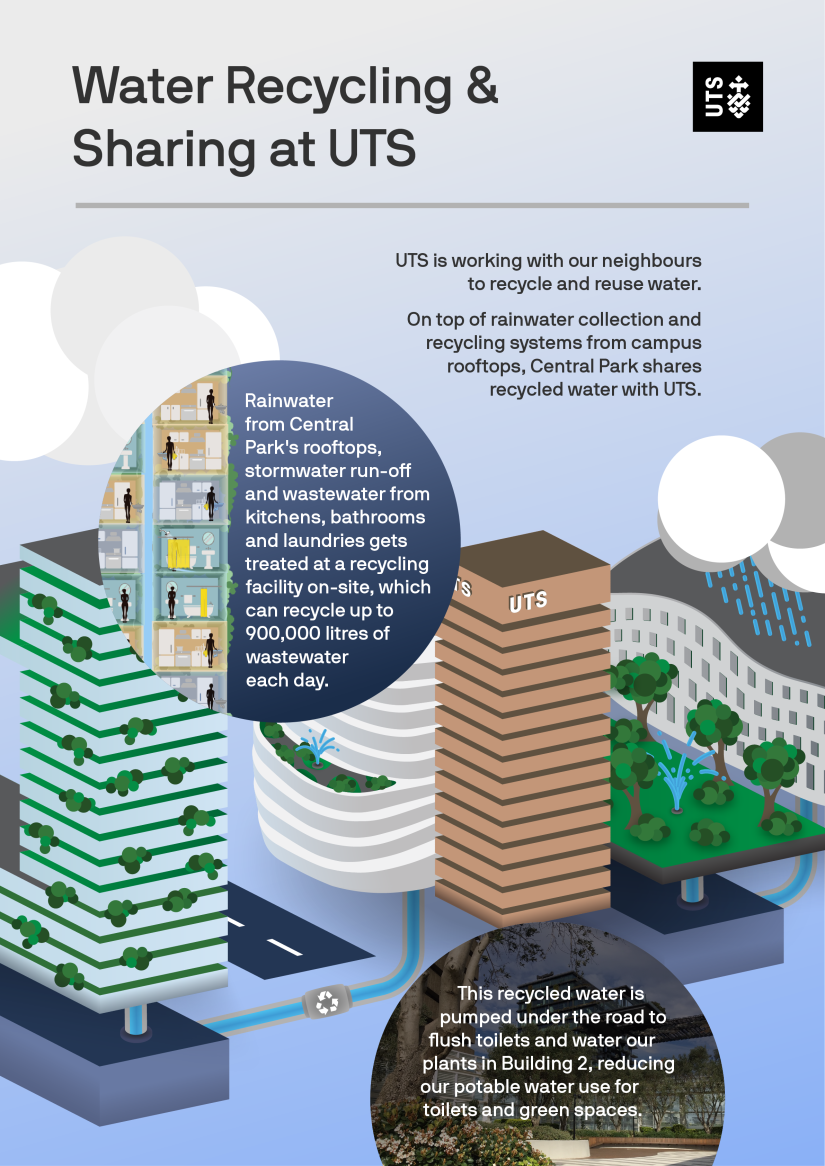
Did you know? At UTS our spaces are cooled using chilled water. This water circulates all around our campus, it even comes under the road from Central Park!
On top of the water UTS chills, water from Central Park travels under Broadway and all over our campus. This means we can share the cooling demand. We can utilise the excess cooling capacity from Central Park when their demand is low.
This builds on our precinct recycled water supply agreement, which waters our plants and flushes our toilets in building 2. All of this cuts down on our energy and potable water use.
Precinct resource sharing
UTS is part of an innovative resource sharing agreement with Central Park that allows us to share recycled water and energy generated by our neighbour across the road. This helps to reduce our potable water and energy use on campus. Learn more below.
Indigenous garden
Waraburra Nura (The Happy Wanderer’s Place) is a native garden built in the heart of the UTS campus on land of the Gadigal people of the Eora Nation. It contains plants native to the Sydney basin used by Indigenous people for medicinal purposes. The garden uses companion planting, where four or five species grow together in a cluster to support and nourish each other. It was designed to help transfer living and practiced Indigenous knowledge to both Indigenous and non-Indigenous people. Along with an associated website, tours and workshops the garden brings Indigenous knowledge to the centre of UTS. The initiative was conceived by UTS Art staff member Alice McAuliffe in collaboration with Jumbunna Institute of Indigenous Education and Research, and in close consultation with D’harawal senior and botanist Aunty Fran Bodkin and designer Nicole Monks. The garden is open to the public and located on level 6 of building 1.

Alice McAuliffe
The Waraburra Nura garden sits on the balcony of level 6 of UTS tower, it was previously a quite underused balcony in the university and we have such little green space.
I had been working with Jumbunna Institute for Indigenous Education and Research for some time, working on creative projects, using art from the collection to talk about Indigenous knowledge, and I came up with the idea to have a garden that focused on native plants from the Sydney area, that would teach people about Sydney Indigenous culture. And the living culture that’s here.
The wonderful designer Nicole Monks came up with this beautiful design for the garden which was based on the cells of chlorophyll. And I also got in touch with the wonderful D’harawal senior and botanist Aunty Fran Bodkin who has an incredible wealth of knowledge about native plants from this area, and their medicinal uses. And she gave me advice on what plants to use in the garden.
And through something as benign as a garden we can get a lot of information across to people about a long history of culture in Sydney, and a living culture that is here now too. I am slowly seeing people starting to talk about Indigenous knowledge, and Indigenous gardens, and medicinal plants in a way that I haven’t seen before when I was growing up here.
And I think that what’s really been the benefit of the garden, that it’s starting to infiltrate conversation. We’ve been on radio, we’ve been in magazines. People are starting to contact me, from different institutions around Sydney, so I am starting to see a growing interest, which I think is wonderful. And I think the more that we can talk about Indigenous knowledge openly and freely the better society is, because we have so much to learn from Indigenous Australians.
Lighting upgrade
To help meet our greenhouse gas reduction target of 30% by 2020/21 some older buildings have undergone an upgrade of lighting. Energy consumption from lighting has been reduced by 50% in some upgraded areas, with more than 700 new T5 fluro tubes and LED lights installed.
People counters
To improve air conditioning efficiency people counters have been installed in most class rooms and lecture theatres in buildings 7, 8 and 11. This means when rooms are only half full the air conditioning automatically adjusts, making the spaces more comfortable while also improving energy efficiency by approximately 25%.
Sensor lighting
New LED sensor lighting has been installed in the fire stairs of the tower building. The super-efficient lights operate at two strengths, very low when there is no motion and fully on whenever motion is detected. By replacing the old lights that were on 24 hours a day, electricity use and greenhouse gas emissions have been cut by over 80% in the affected area.
Water recycling
At the top of the UTS tower building are two of Sydney’s largest air-conditioning cooling towers, consuming approximately 32 million litres of water annually. The water needs to be constantly replenished to avoid becoming too salty and until 2006 was flushed down the drain. Following a series of special projects from 2007 five large recycled water tanks were installed on level 28. The water is now used to flush the toilets throughout the tower, saving millions of litres per year.



